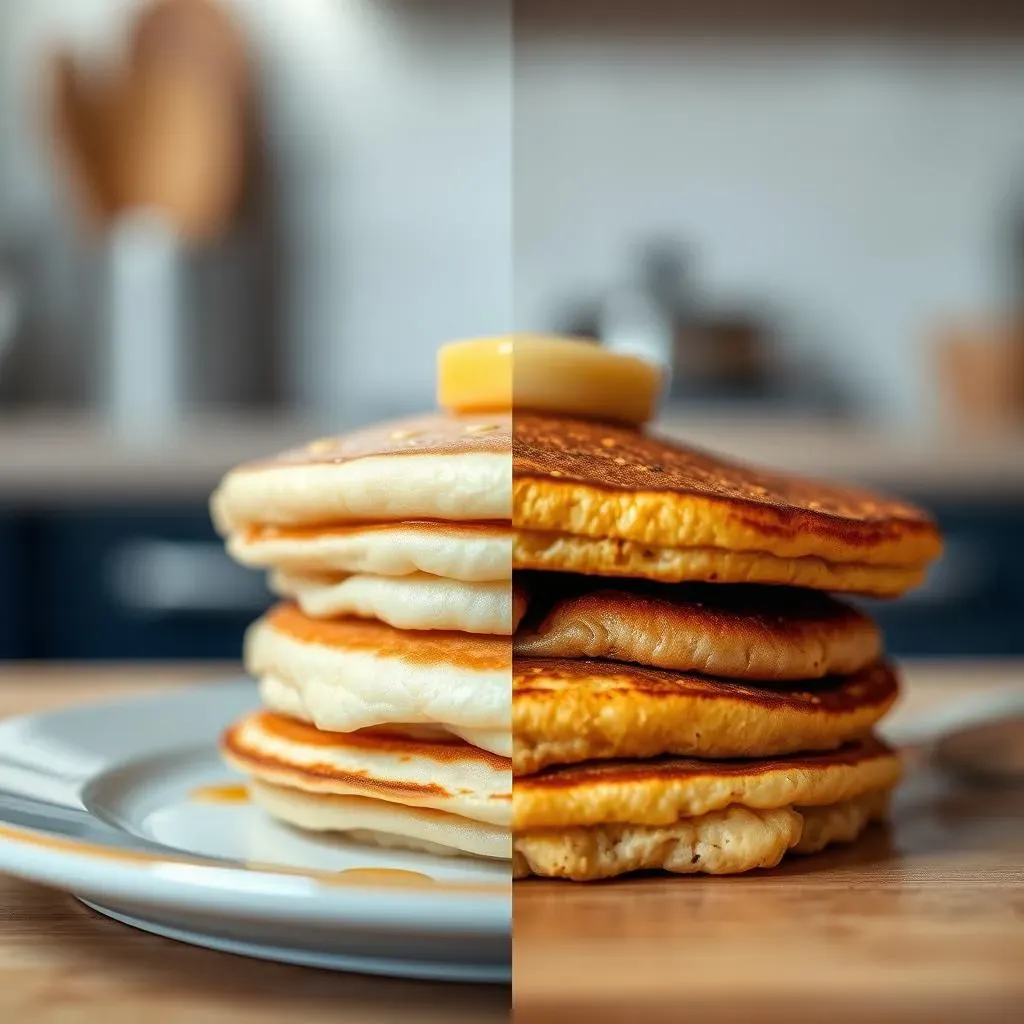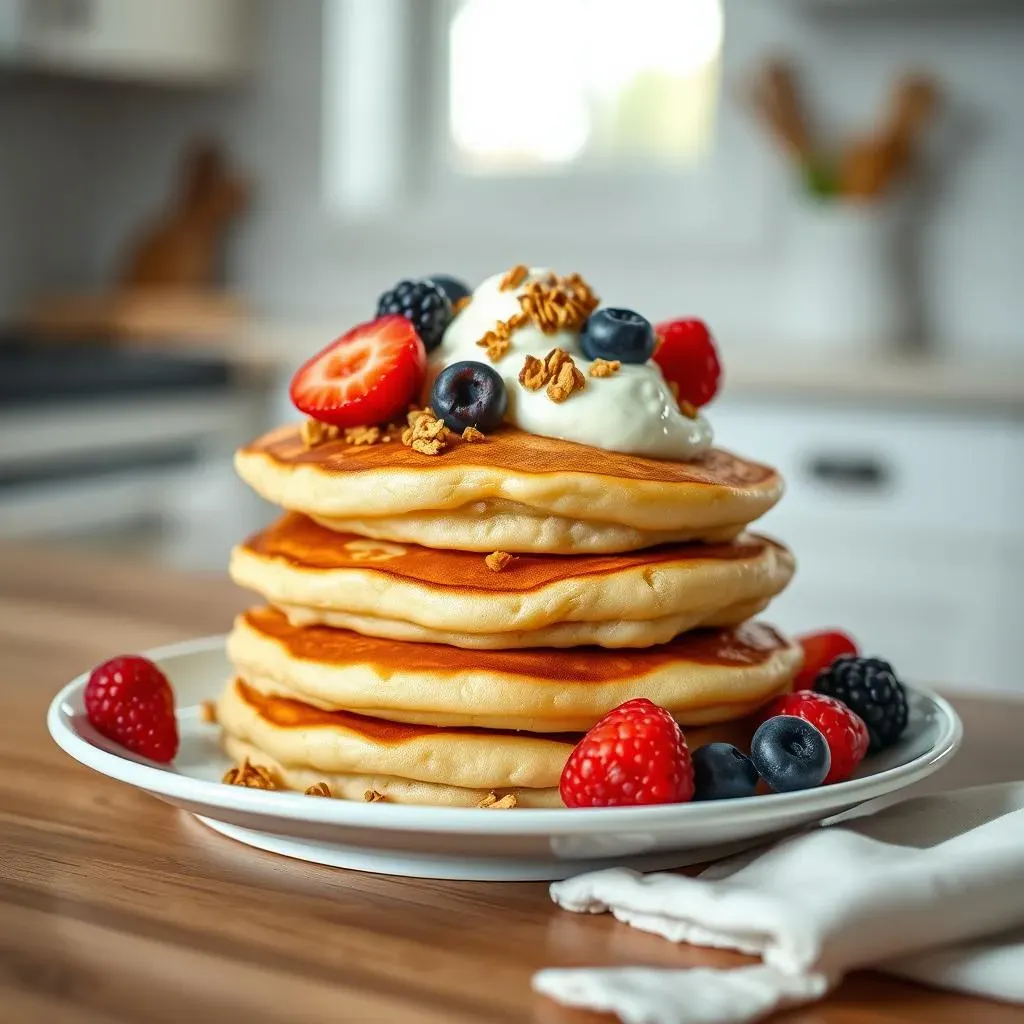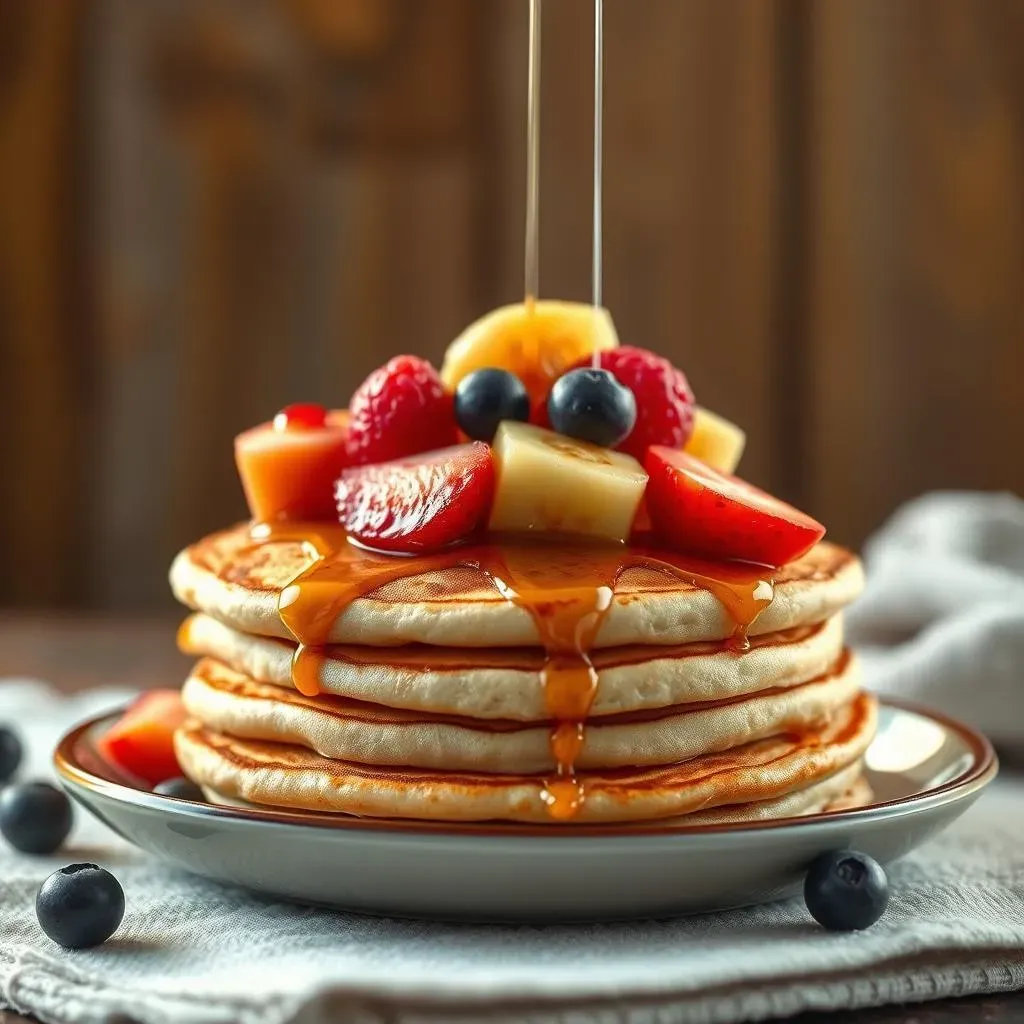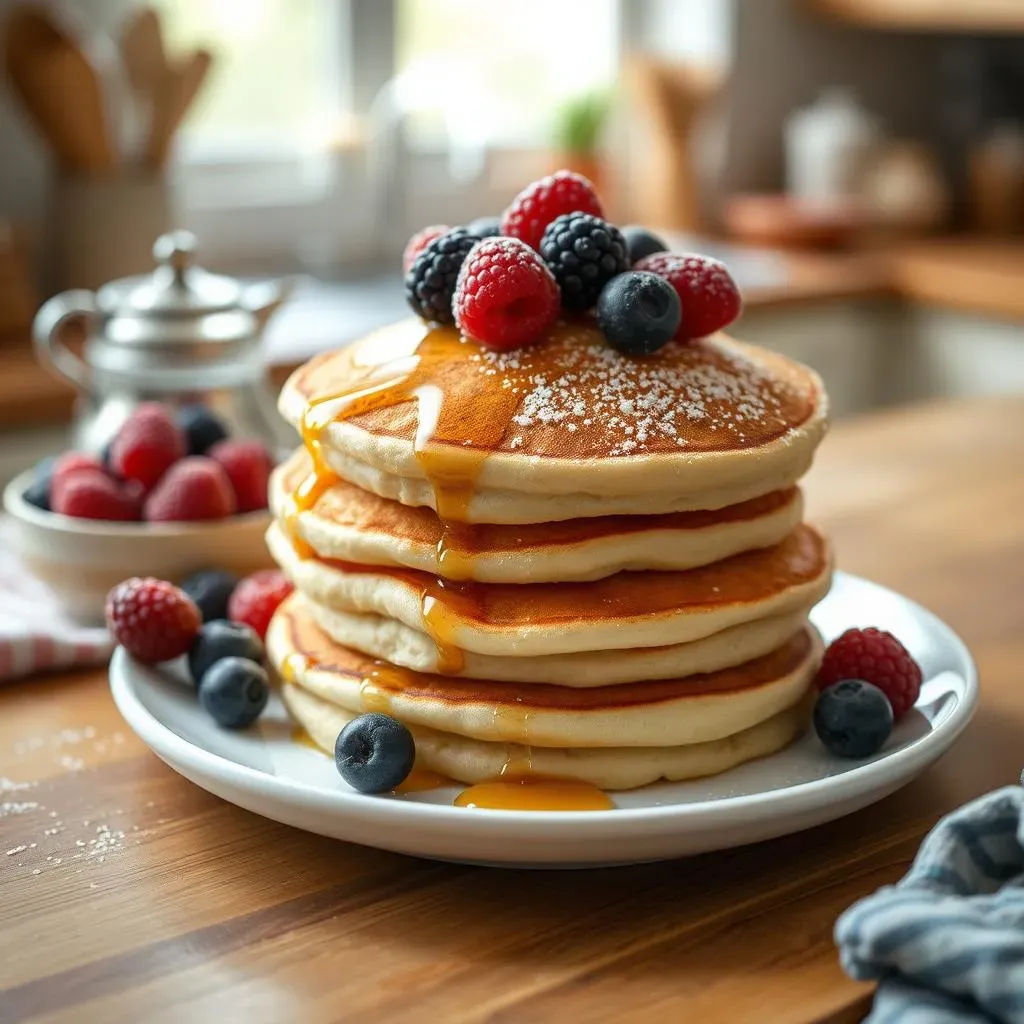Table of Contents
Let's face it, pancakes are amazing. That fluffy texture, that sweet taste…it's pure breakfast bliss. But are all pancakes created equal? This article dives headfirst into the delicious debate of healthy pancakes vs regular pancakes. We'll explore the key differences, examining the nutritional battles between these breakfast contenders. Get ready to uncover the secrets behind healthier pancake recipes, exploring ingredient swaps and clever cooking techniques. We'll even show you how to make delicious, guilt-free pancakes that are packed with nutrients and taste incredible. So, whether you're a pancake purist or a health-conscious foodie, get ready to learn everything you need to know about making the best, and healthiest, pancakes possible. This isn't just about swapping ingredients; it’s about understanding the impact of your choices and crafting a breakfast that nourishes your body as much as it delights your taste buds. Prepare for a delightful journey into the world of healthy pancakes vs regular pancakes – your taste buds (and your waistline) will thank you!
The Great Pancake Debate: What's the Difference?

The Great Pancake Debate: What's the Difference?
Fluffy vs. Flat: A Textural Tale
So, you're diving into the world of pancake perfection, huh? Fantastic! The first thing you'll notice is the HUGE difference in texture between a regular pancake and a healthy one. Regular pancakes, often made with all-purpose flour and plenty of sugar, tend to be light and fluffy, almost melt-in-your-mouth. Think of a cloud – light, airy, and easily devoured. But healthy pancakes? They can vary wildly depending on the ingredients! Using whole wheat flour or oat flour, for example, often results in a denser, chewier pancake. It’s not necessarily *bad*, just different. Think of it like a hearty sourdough bread – substantial and satisfying.
One thing that significantly impacts texture is the amount of leavening agent used. Regular pancakes often rely heavily on baking powder for that airy lift. Healthy versions might use less, or incorporate other leaveners like baking soda, which interacts differently with the batter. This can lead to a less dramatic rise, resulting in a flatter, more compact pancake. Don't worry though, there are ways to get that fluffy texture even with healthier ingredients! Check out our tips for making perfect healthy pancakes for some pro advice.
Pancake Type | Texture | Typical Ingredients |
|---|---|---|
Regular | Light, fluffy, airy | All-purpose flour, sugar, baking powder, milk |
Healthy | Denser, chewier, can vary | Whole wheat flour, oat flour, less sugar, alternative leaveners |
Sweet vs. Savory: A Flavor Face-Off
Let's talk taste! Regular pancakes are usually all about the sweetness. The sugar in the batter, combined with a generous drizzle of syrup, creates a delightful sugar rush. It's a classic for a reason! But healthy pancakes offer more flexibility. While some recipes still incorporate sweetness, many lean towards a more subtly sweet or even savory profile. Think banana pancakes with a hint of cinnamon, or savory vegetable pancakes with herbs and spices. The sweetness isn't the star, it's more of a supporting character.
The flavor differences stem from the ingredients. Regular pancakes rely on refined flour and added sugar for that familiar sweet taste. Healthy versions often use whole grains, fruits, vegetables, or nuts, which introduce a wider range of flavors. These ingredients can lend a nuttier, earthier, or fruitier taste, depending on your recipe choice. For some seriously delicious inspiration, try our healthy pancake recipe with fruit – it's a game-changer!
- Regular Pancakes: Sweet, sugary, classic flavor profile.
- Healthy Pancakes: Can be subtly sweet, savory, or feature a variety of fruit/vegetable flavors.
Nutritional Knockout: Healthy Pancakes Win on Points

Nutritional Knockout: Healthy Pancakes Win on Points
Okay, let's get down to brass tacks: nutrition. Regular pancakes are basically sugar bombs disguised as breakfast. They're typically made with refined flour, which is low in fiber and nutrients. Add in the syrup, and you've got a recipe for a blood sugar rollercoaster. But healthy pancakes? They're a whole different story. By swapping out refined flour for whole wheat, oat, or even almond flour (check out our almond flour pancake recipe!), you dramatically increase the fiber content. Fiber helps you feel full longer, preventing those mid-morning cravings. And let's not forget the added vitamins and minerals from fruits and vegetables you can easily incorporate.
Think about it: a regular pancake might offer empty calories, while a healthy version can be packed with essential nutrients. Adding fruits like berries or bananas boosts your vitamin C and potassium intake. Vegetables like zucchini or carrots sneak in extra vitamins and fiber. You're not just eating breakfast; you're fueling your body with goodness! Want to make extra healthy pancakes for your kids? We have a great recipe for kids that's both delicious and nutritious.
Nutrient | Regular Pancakes | Healthy Pancakes |
|---|---|---|
Fiber | Low | High |
Vitamins & Minerals | Low | High (depending on additions) |
Sugar | High | Lower (can be controlled) |
Protein is another major player in the nutritional game. Regular pancakes are notoriously low in protein, leaving you feeling hungry again soon. But healthy pancakes can easily up the protein ante. Adding ingredients like Greek yogurt (check out our Greek yogurt recipe!), protein powder, or even mashed beans can significantly increase the protein content. This helps you feel fuller for longer and provides the building blocks for muscle repair and growth. It's a win-win!
Let's be honest, sometimes you crave that classic pancake sweetness. But even then, you can make healthier choices. Instead of relying on refined sugar, consider using natural sweeteners like maple syrup (in moderation!), honey, or mashed banana. These offer some nutrients along with sweetness, making your pancakes a more balanced breakfast option. Looking for low-calorie options? We've got you covered with our low-calorie recipe!
- Increased Fiber: Improves digestion and keeps you full.
- Higher Protein: Boosts satiety and supports muscle growth.
- More Vitamins & Minerals: Provides essential nutrients.
- Controlled Sugar: Prevents blood sugar spikes.
Ingredient Spotlight: Flour Power and Sweet Surrender

Ingredient Spotlight: Flour Power and Sweet Surrender
Flour Power: The Foundation of Your Flip
Let's talk flour! This is where things get interesting in the healthy vs. regular pancake debate. Regular pancakes typically rely on all-purpose flour, a refined grain that's stripped of much of its nutritional value. It’s cheap, readily available, and delivers that classic light and fluffy texture. But it’s also relatively low in fiber and lacks the essential nutrients found in whole grains.
Healthy pancakes, on the other hand, often embrace whole grain flours. Whole wheat flour, for example, retains the bran and germ of the wheat kernel, boosting the fiber content and adding valuable vitamins and minerals. Oat flour is another fantastic option, providing a naturally sweet and slightly nutty flavor. Even almond flour can make a delicious and surprisingly fluffy pancake, offering a boost of healthy fats and protein. Want to explore more options? Check out our healthy pancake mix comparison to find your perfect blend!
Flour Type | Nutritional Benefits | Pancake Texture |
|---|---|---|
All-Purpose | Low in fiber and nutrients | Light and fluffy |
Whole Wheat | High in fiber, vitamins, and minerals | Denser, chewier |
Oat | High in fiber, good source of iron | Slightly dense, moist |
Almond | High in healthy fats and protein | Can be light or dense depending on recipe |
Sweet Surrender: Rethinking Sugar
Sugar is the other major player in this pancake showdown. Regular pancakes often pack a hefty punch of added sugar, both in the batter and in the generous helping of syrup that usually accompanies them. This sugar rush is undeniably delicious but it's also a quick route to a blood sugar crash and an energy slump. It's not exactly the ideal way to start your day.
Healthy pancakes take a smarter approach to sweetness. Many recipes significantly reduce or eliminate added sugar entirely, relying instead on the natural sweetness of fruits like bananas or berries. Even a touch of maple syrup or honey can provide a touch of sweetness without the same negative impact as refined sugar. But remember, moderation is key! Want to master the art of sugar-free pancakes? Our sugar-free recipe is a great place to start!
- Reduce or eliminate refined sugar.
- Use natural sweeteners like fruit, maple syrup, or honey (in moderation).
- Embrace the natural flavors of whole grains and other ingredients.
Beyond the Basics: Elevating Your Ingredients
Don't be afraid to experiment! Healthy pancakes are a blank canvas for culinary creativity. Think beyond just flour and sugar. Incorporate nutritious additions like chopped nuts for healthy fats and protein, seeds for added texture and omega-3 fatty acids, or even grated vegetables like zucchini or carrots for extra vitamins and fiber – without compromising taste! It’s amazing how much flavor and nutrition you can pack into a simple pancake.
The beauty of healthy pancakes is their versatility. You can adapt them to suit your dietary needs and preferences. For vegan options, explore plant-based milks and egg replacements. If you're watching your calorie intake, focus on lighter flours and reduce the amount of oil or fat. Need a quick and easy breakfast? Our easy healthy pancake recipe is perfect for busy mornings. The possibilities are endless!
“The best recipes are the ones that are both delicious and nourishing,” says renowned chef and nutritionist, [Insert Name Here]. “Don’t be afraid to experiment with flavors and textures to create pancakes that are as healthy as they are satisfying.”
Recipe Remix: Making Healthy Pancakes Happen

Recipe Remix: Making Healthy Pancakes Happen
Mastering the Batter: Tips & Tricks
Okay, let’s get our hands dirty! Making healthy pancakes isn't rocket science, but a few tweaks can make all the difference. First, the wet ingredients are key. Using a milk alternative like almond milk or soy milk adds a subtle flavor and nutritional boost. And don't underestimate the power of eggs (or a flax egg substitute for vegans)! They bind the batter, add richness, and contribute to that coveted fluffy texture. If you want extra fluffy pancakes, consider adding a little bit of extra baking powder.
Next, consider your dry ingredients. The type of flour you choose dramatically impacts the final product. Whole wheat flour adds fiber and nutrients, but it can also make the pancakes a bit denser. If you prefer a lighter texture, try a blend of whole wheat and all-purpose flour. Or, experiment with oat flour for a naturally sweet and slightly nutty flavor. For some extra inspiration, check out our whole wheat pancake recipe - it's a winner!
- Use milk alternatives for extra flavor and nutrients.
- Eggs (or flax eggs) bind the batter and add richness.
- Experiment with different flour blends for varied textures.
Sweetening the Deal: Healthy Alternatives
Let's talk sweetness. While some healthy pancake recipes embrace the natural sweetness of fruits and vegetables, you might still crave a touch of extra sweetness. Instead of reaching for refined sugar, explore healthier options. Maple syrup, honey, and even mashed banana or applesauce can add delicious sweetness without the sugar crash. Remember, even natural sweeteners should be used in moderation!
The key is to balance sweetness with other flavors. Spices like cinnamon, nutmeg, or cardamom can complement the natural sweetness of fruits or vegetables, creating a complex and satisfying flavor profile. Don't be afraid to experiment! Adding a touch of vanilla extract can also enhance the overall flavor of your pancakes. For some truly decadent (but still healthy!) options, check out our healthy pancake topping ideas – they're amazing.
Sweetener | Nutritional Benefits | Flavor Profile |
|---|---|---|
Maple Syrup | Antioxidants, minerals | Rich, buttery |
Honey | Antioxidants, antibacterial properties | Sweet, floral |
Mashed Banana | Potassium, fiber | Naturally sweet, slightly fruity |